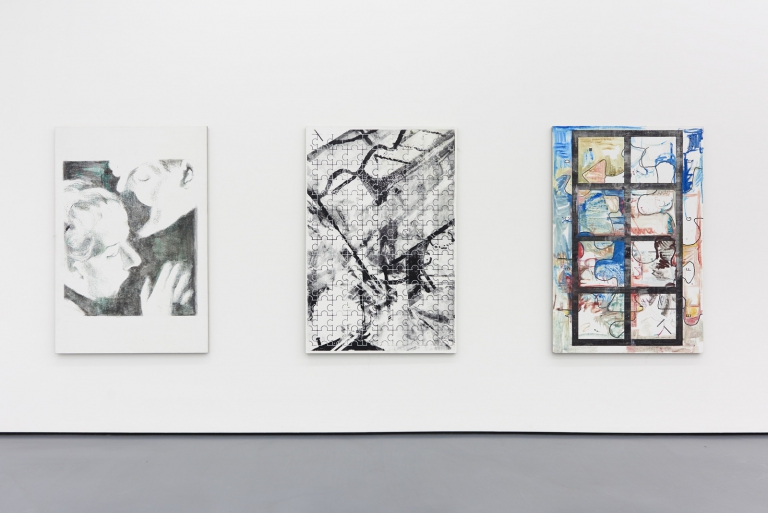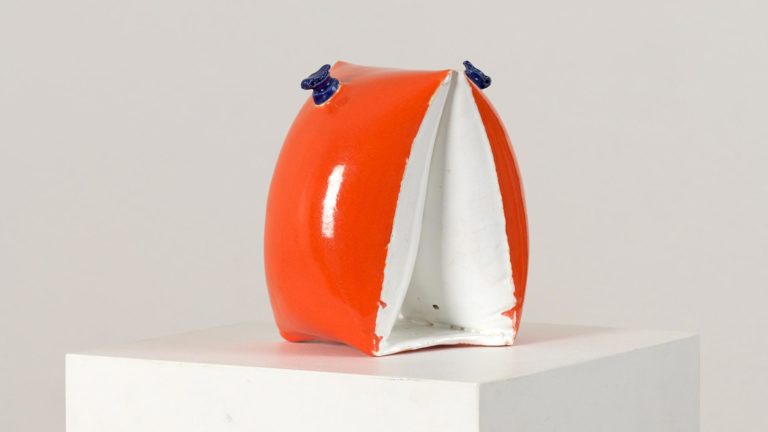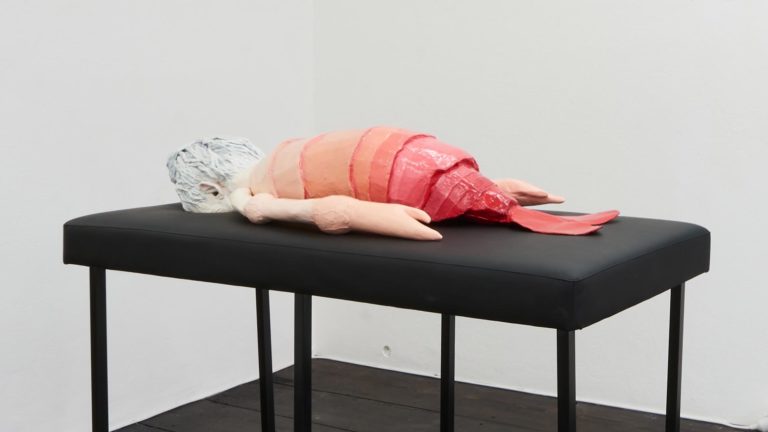Artist: Caroline Wong
Exhibition title: Cats and Girls
Venue: Soy Capitán, Berlin, Germany
Date: September 16 – November 12, 2022
Photography: images copyright and courtesy of the artist and Soy Capitán, Berlin
HER AND HER WOMEN
Caroline Wong’s pastels of females and felines feasting together force a duality, eliciting a mixture of joy and revulsion, provoking pleasure with disgust. While nauseating, while dizzying, they are cathartic too, life-affirming. Her women: drunken, disheveled, shouting, on the verge of vomiting, spilling sauces, regurgitating soda, bent over the table, splayed out on the bed, kneeling on the floor, slurping, licking, chewing, consuming.
Occasionally a character in her own work, and instantly recognisable, Wong too is there, feeding in this frantic, frenetic way. Her and her close female friends gather together in these maximalist large-scale works for elaborate orgy-like dinners. They are a strange sort of staged Happening, a Fluxus-type rule-dictated event, like a form of outwardly-chaotic-seeming Dada poetry, with firm rules, rigid structures and instructions, as the underlying foundation, dictated in the back. Reading like performance art, a concept that has been documented. Wong writes that, “When I make work, I am a bit of a robot”. Removing herself from the present, she inserts herself into the pictorial.
Her, and her women are (what society would agree are) beautiful. She could paint them as grotesquely obese, but she chooses this more slender subject because they are all, really, very much like her. She is painting herself, and her friends as versions or stand-ins, likenesses of herself, allowing herself to eat because they, also, are her.
IF THIS WERE A FLUXUS HAPPENING
The Instructions would read as follows:
A) Stand here, with these women. These women who are like you, like me. Feel comfortable.
B) Choose a position. Any position. Take a look at the cats around you, for inspiration. Observe how they pose, observe how they eat.
C) Begin to eat.
D) Ask yourself, as you eat, the following questions:
What do I feel, as I eat? Shame? Self-awareness? Joy? Why?
Am I over-indulging? What is the right and deserved amount of indulgence?
Who determines what is too much, who determines these rules, to begin with?
How do I abolish these rules and learn anew?
Am I eating properly? How do I eat properly?
How do I tell if my diet is beneficial physically and emotionally?
How do I detect, diagnose, define an eating disorder?
How do I ascertain whether the products I consume, marketed to me as a woman, are harming me, or strengthening me?
Should I see a nutritionist? If I do, how do I make sure to avoid medical gaslighting?
How do I steer clear of oppressive modes of thought, around eating?
How do I ignore those ignorant comments from men, friends, family, about my appetite, my body?
Is it me who grants me the approval to consume, who dictates what I eat, who takes it away?
E) Or, as you eat, maybe ask yourself no questions at all. Just eat. Prioritise your pleasure.
Environment for the Happening: A Messy Girl’s Bedroom, with many girls, and many cats, and many dishes of food.
BALTHUS AND HIS CATS
Wong has re-purposed the exhibition title of Cats and Girls from a Balthus exhibition at the Met in 2013, which examined the French painter’s oft-utilised subject matter of cats, with girls. Balthus had a childhood cat that he lost, and his work resonates with Wong, flooding her with a longing for, and desire to re-live, childhood. She writes of how she too “grew up with a cat. He was always around, accompanying me and my friends, always in the background, and we would make him part of the games”. This cat, for Wong, is a little guardian, a protective figure. A playmate, but also, at the same time, the responsible one keeping an eye on all of the children, looking over, keeping watch. Observing.
Cats are excellent at observation. Girls and women are accustomed to being observed. Balthus played the role of the observer, not the observed. Balthus is the beholder painting the beheld, but Wong is her own subject, painting herself and her cohorts, both observer and observed, both cat and girl. Balthus has been condemned in recent years, for this disquieting distance in his perspective, for this unnerving baggy sense of perviness, but Wong can’t help but feel drawn to his images and to his themes, re-shaping them, re-working them in a new, more liberating context, in an effort to shed that stale, clinging discomfort, to unfurl and peel off that fraught energy, to pivot instead toward the very real fruitful affinity of young female and feline friend that engulfs her whole spinning, pleasure-seeking consciousness.
She paints herself and other women as women, adult women, not as Balthus’ nymphettes. They behave like children, but they do not present as children. Wong writes of how her ‘girls’ are “women in their 20s and 30s, but under the influence of food, drink, each other, and their feline companions, they tap into a much younger, more childlike, wilder, sillier self”. She, and her girls, are intentionally attempting to rid themselves of all societal constructs, to instead act how they please, in ways that society only permits children to act. Her works proclaim alterity, difference, while also being connected and whole. Her girls shout, we are inside our bodies. It is only when we live outside of our bodies, divorced from and rejecting their needs and demands, that we feel otherness. We need to substantiate ourselves, illuminate ourselves, make ourselves whole. To feed yourself is to exist, and on top of that, to grow. Pushing away that which is sterile, cold, static, monotone, Wong’s work is enmeshed in itself, in herself, in the loudness and warmth of femme and queer culture.
While Balthus’ work reads as lofty, Wong’s work is concerned with the corporeal. Children indulge in the physical, occupied primarily with responses based on real, visceral, powerfully-felt senses. Selfish creatures, listening to their bodies. Desire, hunger, what one wants, are the hallmarks of both cats and children. Cats are one moment languid, lethargic, the next moment tense, rigid, taut. Cats and girls are both not tamed, not yet. Infinitely soft and gentle one moment, purring, cooing, the next moment sharp and stiff, biting, clawing. Hating and loving at once, flitting between the two very fast.
IMAGINARY WORLD
Wong transports us to this enclosed, unreal world of girl-dom, with cats as childhood companions and guardians. Her works push us into that tangible zone, the sheltered, separated world that children and domesticated animals inhabit together. She talks of how these works are an “escapist regression into the nonsensical fantasy worlds of childhood”. She chooses to inhabit this space of the girl, a child and a woman, to equate her to the cat, an animal. But her girl-cats here are decidedly not the prey. They are the predator. The tear and pull and bite and chew, they feast and attack. They enjoy their spoils. Her girls are full of life, bold and powerful. Who gives these women their power? Themselves? The feline and the feminine are elegant and erratic. At the same time wild and gentle, angelic and diabolic.
Wong writes of how she “channels anxiety and restlessness as much as pleasure and excitement into the drawings”, pointing to her own difficult relationship with food and with claiming her own pleasure, naming her own needs – the struggle that many women face in the midst of such a massive dearth of support and education. The pleasure and indulgence that one feels when gorging on lots of food, telling herself that it is okay to experience that type of pleasure, to not feel that guilt. In these nauseating positions, with these nauseating expressions, situated in the midst of these nauseating compositions with too much going on. Mess, vomit, crumbs of food, the messy joy of eating, with moments of disgust, not like a food commercial where everything is polished or sexy.
Eating and sex are related, however, both messy, bodily functions that are both very necessary but also both very complicated. And any way that you depict a woman eating, it will be sexualised, because women are so hyper-sexualised in our world. Even the act of them performing a natural, necessary survival activity is interpreted as the pleasure it could give others rather than the pleasure it gives to themselves. Wong is here, again, not the distant observer sexually evaluating her subjects, but rather transporting her own self to that mode of childhood, that innocent place where she doesn’t have to feel observed at all, and can feel free. Her work is about her, wanting to be a child again, to be silly, and to be lost. She notes, “Peter Pan Syndrome is a concept that is usually for men, how funny is that?”
MEIREN HUA
Responding to many art history traditions, Wong cites Degas, Foujita, Bonnard and Intimism as inspiration. She
also pulls many of her animalistic women’s poses out of Chinese scroll paintings of cats, and sees parallels in Paula Rego’s Dog Women drawings. But most of all, thematically and stylistically, her work consciously subverts Chinese meiren hua. A genre that translates to ‘images of beautiful women,’ meiren hua depicts the ideal woman of various periods in Chinese history. They are elegant, passive women leading interiorised lives in the confines of a palace or a brothel, always very enclosed, portrayed as examples of perfection for other women to follow, in the tight and constrained and infinitely precise house style of the time. Born in Malaysia to Chinese parents, Wong acknowledges her own shyness as a product of her upbringing. She depicts women who are flush with life and passion, full with desire and greed, replete with feeling.
Wong also references and dismantles the meiren hua tradition in her medium, and in her sloppy, unrestrained, sweeping gestures. She writes that she has “chosen drawing for its quickness and immediacy; everything for me is about the body – the freedom of the body’s movement in the making of the image, the need to make things quickly as if gorging on a feast. The aim is for the image to not be too complete or perfect, as if the drawing itself is hungry and is in the process of feeding. Ultimately, because of the incompleteness of the image, it remains somewhere between hunger and satiation, fantasy and reality”. While classically trained in portraiture painting, she prefers charcoal and pastel as they “allow me to go back and forth, adding, erasing, and layering marks to my satisfaction; the traces of drawing, unlike painting, reveal a messy, frantic quest for substance – it is my hunger laid bare”. She creates these works on throwaway, scrappy sheets of paper. Her choice of materials intentionally unrefined and rough, the stuff that you give children to experiment with.
TO SERVE A BODY
Wong takes up space, fills space and makes space, at a large scale. Themes around femininity, queerness, anxiety, desire, and the right to female pleasure, pervade her pieces. Saturating each canvas, her mission is to fill that void, to feel no guilt or shame for taking what one needs and wants. But there is that anxiety too, the need to identify what one needs and wants, and the fear that this process of identification will be harder to achieve than one hoped. By taking control of their bodies and diets themselves, Wong’s women still feel out of control. The works signal a release, but with this release, comes also, a panic. Do we take the woman out of the kitchen, free her from this realm, or do we instead claim and conquer this realm as an important aspect of her identity? How do we identify whether our relationships with other women, like our diets, are positive or toxic? How do we tell if a female friendship is supportive, soul-nourishing and sustaining, or damaging? Is society’s crazy cat lady stereotype being examined here? Are these works about loneliness, companionship with other women and with cats? Are they happy, or sick? What is the line between comfort and addiction, the line between freedom and isolation?
Women’s relationship to food: warped, uneasy, imbalanced, distorted, sharply out of wack. Food: straightforward, essential, human necessity, human right. Women must be nourished, sated both physically and emotionally. Society has so heavily criticised women’s behavior and practices around eating. Awash in this current moment by such strong tides, we are drowning in efforts to discipline and control the bodies of women. Women’s rights over their own bodies are coming increasingly under attack, stripped from them, like their appetites. Wong asserts in her work that we must, loudly and unyieldingly, claim our bodies back.
– Amelia Wilson
Caroline Wong, Cats and Girls, 2022, exhibition view, Soy Capitán, Berlin
Caroline Wong, Cats and Girls, 2022, exhibition view, Soy Capitán, Berlin
Caroline Wong, Cats and Girls, 2022, exhibition view, Soy Capitán, Berlin
Caroline Wong, Cats and Girls, 2022, exhibition view, Soy Capitán, Berlin
Caroline Wong, Cats and Girls, 2022, exhibition view, Soy Capitán, Berlin
Caroline Wong, Cats and Girls, 2022, exhibition view, Soy Capitán, Berlin
Caroline Wong, New year’s eve dinner, 2022, pastel on paper (yellow), 180x246cm
Caroline Wong, Birthday Party (After Foujita), 2021, pastel on paper, 272x322cm
Caroline Wong, Drawing Room (after Balthus), 2021, pastel and charcoal on paper, 217x150cm
Caroline Wong, Tteokbokki, 2022, pastel on paper, 50x65cm
Caroline Wong, Untitled, 2022, pastel on paper, 50x72cm
Caroline Wong, Fruit salad, 2022, pastel on paper, 50x65cm
Caroline Wong, Instant noodles, 2022, pastel on paper, 50x65cm
Caroline Wong, Tagliatelle, 2021-2022, pastel on paper, 65x50cm
Caroline Wong, Cheesy chips, 2021-2022, pastel on paper, 50x65cm
Caroline Wong, Tempura prawns, 2021-2022, pastel on paper, 65x50cm
Caroline Wong, Peach, 2021, pastel on paper, 70x50cm
Caroline Wong, Cats and Girls, 2022, exhibition view, Soy Capitán, Berlin
Caroline Wong, Cats and Girls, 2022, exhibition view, Soy Capitán, Berlin
Caroline Wong, Antipasti, 2022, pastel on paper (pink), 135x190cm
Caroline Wong, Cats and Girls, 2022, exhibition view, Soy Capitán, Berlin



























